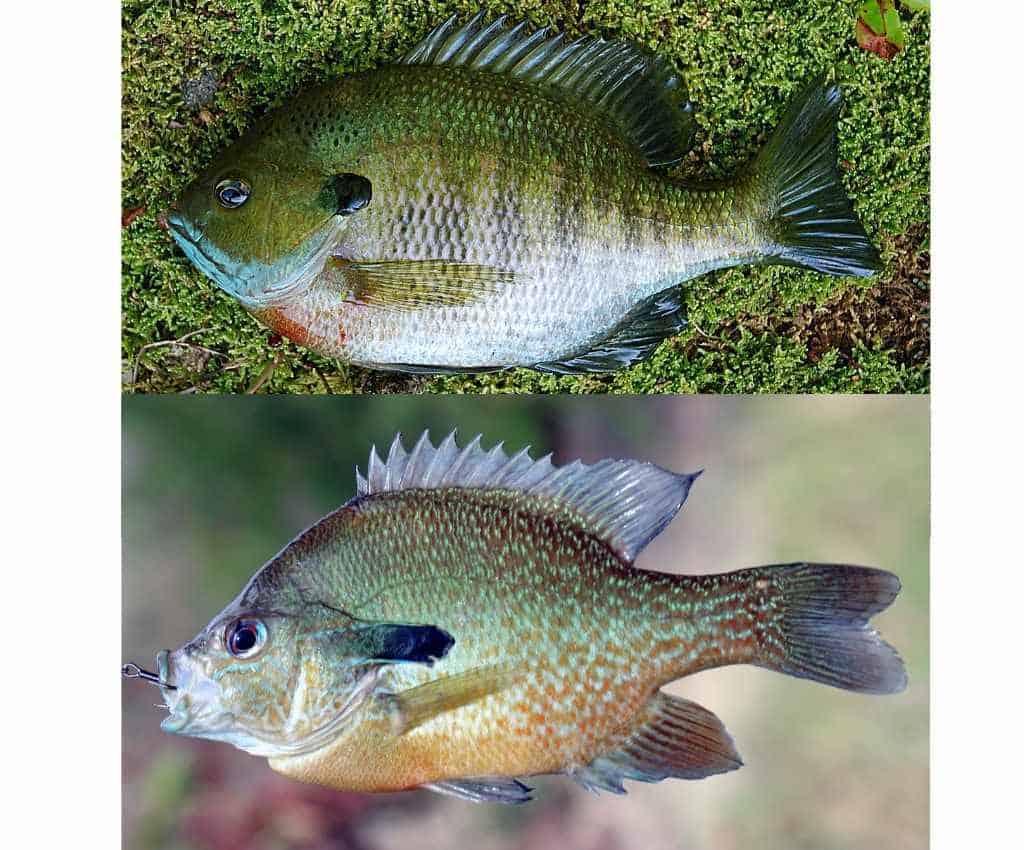Bluegill vs Redbreast Sunfish: The Differences! Panfish
Bluegill and redbreast sunfish have many similarities. For this reason many people wonder about their differences. Therefore, let’s answer, are redbreast sunfish and bluegills the same?
Redbreast sunfish and bluegill are different species of fish although they are from the same family. Bluegill is the L. macrochirus species and redbreast sunfish is the L. auritus species. The most identifiable difference is the longer gill ear flap of the redbreast sunfish compared to the shorter bluegill flap.
This article will compare both sunfish tastes, textures, cooking methods, costs, mercury levels and whether one can substitute for the other in recipes. In addition, I’ll do a side-by-side comparison of their habitats, appearance and compare their nutritional value.
Bluegill vs Redbreast Sunfish: Habitats, Size, Weight and Appearance
How can you tell the difference between the two fish?
To tell the difference between a bluegill and a redbreast sunfish compare their gill ear flap, dorsal fin, head coloring and body shape. Redbreast’s ear flap is elongated compared to the shorter, rounder ear flap of the bluegill. Bluegill have a dark spot at the dorsal fin base the redbreast doesn’t have. Bluegill have blue coloring on the cheeks and gills compared to reddish orange on the bluegill. The bluegill’s body is rounder than redbreasts.

Redbreast sunfish reddish orange belly color extends further down towards the anal fin. The bluegill’s reddish orange belly coloring is more towards the front than rear.
Redbreast sunfish have teeth on the roof of the mouth. Bluegill’s mouth roof doesn’t have teeth.
Bluegill Sunfish and Redbreast Sunfish Scientific Classifications, Families, Species
Bluegill are from:
- Family: Centrarchidae
- Genus: Lepomis
- Species: L. macrochirus
- Common nicknames: Bream, brim, panfish, sunny, sunnies, perch.
Redbreast Sunfish are from:
- Family: Centrarchidae
- Genus: Lepomis
- Species: L. auritus
- Common nicknames: River bream, red bellies.
Other Sunfish Species: Redear Sunfish, Green Sunfish, Pumpkinseed Sunfish
Some other common sunfish species include redear sunfish, green sunfish, pumpkinseed sunfish, crappie, rock bass, smallmouth bass, largemouth and spotted bass.
Yes, smallmouth, largemouth and spotted bass are part of the sunfish family.
Habitats
Bluegill
- Native to North America and can be found from Canada to northern Mexico.
- When fishing they can be found in streams, ponds, lakes and rivers.
- They like to hide under fallen logs, piers or in weeds.
Redbreast Sunfish
- Native to the eastern United States and Canada. They can be found from Canada down to the east coast of Florida and west to Texas.
- When fishing they can be found in rivers, lakes and streams.
- They like to stay near shelter, structure, rocks, vegetation and near banks.
Appearance
Colors
- Bluegills have an olive green upper body and light yellow breast to orange belly. The sides of the head and chin are iridescence blue or purple. They have dark vertical bands on its sides. A breeding male will have more orange than yellow on the belly.
- Redbreast sunfish have a dusky brown/olive green upper body with green to yellow sides and a reddish-orange belly. It has bluish streaks around the eyes and cheeks. The elongated gill flap (ear) is black.
Both sunfish are colorful. The redbreast typically has more red along the length of the entire belly.
Dorsal Fins
- Bluegill has one dorsal fin with 6-13 spines and 11-12 rays.
- Redbreast has one dorsal fin with 10-11 spines followed by 10-12 rays.
Mouth
- Both sunfish mouths are small, and the jaws don’t extend to the eye line.
The redbreast has a longer snout compared to the bluegill which has a more streamlined mouth and head which blends into the body. The redbreast has teeth on the roof of the mouth, and bluegills don’t.
Scales
- Both sunfish scales are similar size across the body and head.
Body Shape
- Bluegill are flat and have a rounder shape. The mouth hardly protrudes and is more streamlined.
- Redbreast sunfish are flat and not round. They are more elongated.
Size and Weight
- Bluegill average 6-7″ long and weighs less than 2 pounds.
- Redbreast average 4-9″ long and weighs 1-1.5 pounds.
Lifespan
- Bluegill average 5-6 years.
- Redbreast sunfish lives up to 7 years.
Diet
Bluegill consume the following:
- Worms
- Small crustaceans
- Insects
- Insect larvae
Redbreast consume the following:
- Worms
- Insects
- Insect larvae
- Small crustaceans
Find out how green sunfish compared to bluegills in my sunfish article, Green Sunfish – What’s The Difference?
Fishing
When fishing for bluegill sunfish, fishing reports state the best time is during the spring and summer spawn.
Typically, the sunfish will be in two to six feet of water under cover. Bait may include a piece of worm, crickets, grasshoppers and red wrigglers.
On larger freshwater fishing reservoirs, bluegills can be found deep in the backs of pockets along flatter banks. Don’t go fishing offshore too much.

Tastes and Textures
One of the most important things people takes into consideration when choosing a fish or fishing is its taste. When comparing the two sunfish, bluegill vs redbreast sunfish, does one taste like the other?
Redbreast sunfish taste similar to bluegill and has a mild to sweet taste. Both sunfish have a firm, flakey texture.
Redbreast sunfish tastes good to most people and has a mild to sweet taste. The white flesh is flakey and slightly firm.
Depending on the time of year or type of water, both sunfish can taste slight muddy or fishy to some people. The fish can be soaked in milk to help eliminate any unpleasant taste or odor.
- 61% said they preferred bluegill.
- 30% said they preferred redbreast.
- 9% said they had no preference.
To conduct more research, I set up a taste test at home. Both fish were cooked and seasoned the exact way. 75% said they preferred the blue sunfish
Substitutions
When preparing recipes for dinner it’s not always possible to locate the type of fish in a store or find it while fishing. If you have one sunfish, you may ask, can I substitute one for the other?
Redbreast sunfish and bluegill can substitute for each other due to their similar tastes and textures. Both sunfish can be used in many of the same recipes and cooking methods. They both can be cooked by baking, broiling, steaming, grilling and pan frying.
Bluegill substitutes:
- White crappie
- Black crappie
- Pumpkinseed
- Redear
- Pollock
- Lake herring
Redbreast sunfish substitutes:
- Bluegill
- White crappie
- Black crappie
- Lake herring
- Tilapia
- Pollock
- Redear
Crappie is a little easier to find than some of the other sunfish. See how crappie compared to other sunfish in my article, Crappie – What’s The Difference? Let’s Compare.
Bluegill and Redbreast Sunfish Mercury Levels
The EPA and The FDA have issued suggestions and warnings about mercury levels in fish and how often they should be consumed1. This is especially important for young infants, pregnant women and developing children.
They established three lists. Best fish, good choices and ones to avoid based on their mercury levels. Therefore, which sunfishhas more mercury?
Redbreast sunfish and bluegills have similar levels of mercury. Both sunfish are listed on the FDA’s best choice of fish regarding mercury levels.
If you’re pregnant, breast feeding or has a young child, Always check with a physician prior to eating new foods, sunfish or changing your dietary habits.
These mercury warnings can change over time or affect only a particular area or state. Please check with your local EPA and FDA for the current recommendations prior to fishing for sunfish2.

Panfish Costs
The costs for sunfish will vary depending on how they were caught fishing and where they’re sold. When purchasing any fish, be sure to check the label. Therefore, which sunfish is more expensive?
Redbreast sunfish and bluegills have a similar price. The average cost for either sunfish fillets are $19.43 per pound.
Redbreast sunfish fillets are extremely difficult to find for sale. Bluegill or “sunfish” are easier to find online.
To conduct original research on sunfish prices, I checked some stores. First I checked online at Walleye Direct and found the following prices:
- Wild, bluegill fillets
- $25.36 per pound
Seafood Markets:
- Wild, sunfish fillets (does not specify which kind of sunfish)
- $18.00 per pound
Dixon Fisheries:
- Bluegills
- $14.95 per pound
For stocking ponds, Pond King has the following price per sunfish:
- Hybrid bluegills (green sunfish x bluegill) $0.75 per 3-4″ fish
- Bluegill – $0.75 per 3-4″ fish
I recently wrote a sunfish comparison article with pumpkinseed. Their differences may interest you. Check out my article here, Pumpkinseed – Are They The Same? Let’s Compare.

Nutrition
Both sunfish are an excellent source of healthy fats, protein, B vitamins and minerals. Both sunfish contain the following:
- Omega-3 fatty acids
- Folate
- Niacin
- B6
- B12
- B5
- Thiamin
- Riboflavin
- Potassium
- Magnesium
- Iron
- Selenium
- Calcium
- Zinc
The following number of nutrients per four raw ounces of bluegill fish:
| Nutrient | Bluegill, raw (4 Ounces) |
| Calories | 129 |
| Fat | 0.8 g |
| Saturated Fat | 0.5 g |
| Cholesterol | 97 mg |
| Protein | 22 g |
| Sodium | 82 mg |
| Omega-3 | 0.16 g |
| B-6 | 0.1 mg |
| B-12 | 2.0 mcg |
| Thiamin | 0.10 mg |
| Riboflavin | 0.10 mg |
| B5 | 0.7 mg |
| Iron | 1.7 mg |
| Niacin | 1.4 mg |
| Folate | 17.0 mcg |
| Potassium | 395 mg |
| Magnesium | 34 mg |
| Phosphorus | 203 mg |
| Calcium | 90.4 mg |
| Zinc | 1.6 mg |
| Selenium | 14.2 mcg |
Both sunfish provide almost an equal number of the same nutrients. Keep reading the next section below to find out how the nutrients are beneficial, especially omega-3s.
Since the sunfish are difficult to locate in stores, I’ll consume either fish available to me for their nutrient content, taste and health benefits.
Redbreast Sunfish and Bluegill Health Benefits
Omega 3 Fatty Acids
The omega-3 fatty acids are heart healthy and help keep arteries healthy. The omega-3s may help with the following:
- Reduce inflammation.
- Reduce plaque buildup.
- Keeping bad cholesterol low.
- Keeping good cholesterol high.
- Lowering triglycerides
- Help keep the heart rhythms more normal.
DHA and EPA, two of the fatty acids, are associated with lowering blood pressure and improving the health of blood vessels ((National Center for Biotechnology: Marine Omega-3 Supplementation and Cardiovascular Disease)).
Studies suggest omega-3s can help reduce joint pain and stiffness in people with rheumatoid arthritis. They may also boost the effectiveness of anti-inflammatory drugs.

B Vitamins
The B vitamins provided by sunfish include B1 (thiamin), B2 (riboflavin), B3 (niacin), B9 (folate) B6, B12 and B5. B vitamins help support the following:
- Digestion.
- Brain function.
- Energy levels.
- Red blood cells.
- Cardiovascular disease.
- Nerve function.
Magnesium
Both sunfish provide about 34 mg of magnesium per four ounces. It calms and relaxes the whole body including blood vessels. Magnesium has been shown to help improve sleep related problems like insomnia ((National Institutes of Health: Magnesium)).
Magnesium helps keep blood pressure levels balanced and stable. A recent study researched 22 studies and concluded magnesium supplementation decreased diastolic and systolic blood pressure5.
Magnesium helps control muscle and nerve function, blood sugar and blood pressure.
In the muscles and heart, magnesium competes with calcium to help the muscles relax after contracting. When the body is low in magnesium, calcium can over stimulate the heart muscle’s cells causing a rapid or irregular heartbeat.
Calcium
Both sunfish provide approximately 90 mg of calcium per four ounces. Calcium is important for blood pressure and the heart. Harvard Health reports calcium helps maintain blood pressure because it helps to control the relaxing and tightening of blood vessels6.
Calcium also helps the following:
- Muscles need calcium to function properly.
- Improve nerve function.
- Build and maintain strong bones.
Potassium
The potassium provided helps the body get rid of excess sodium which helps reduce fluid build-up. These help keep systolic and diastolic blood pressure lower ((American Heart Association: How Potassium Can Help Control High Blood Pressure)).
The more potassium you consume, the more sodium your body will lose. Consuming too much sodium or not enough potassium throws off the delicate balance the kidneys need to remove the excess water7.
According to Harvard Health, a number of studies have shown a connection between low potassium levels and increased blood pressure8.
Selenium
There are 14.2 mcg of selenium per four ounces of either sunfish. I’m unsure why many don’t write about it more because studies9 show selenium may help to protect the following:
- The immune system
- Thyroid
- Cognitive issues
- Heart disease
Phosphorus
Both sunfish provide approximately 203 mg of phosphorus per four ounces. It has been shown in scientific research to help with the following:
- Promote healthy nerve conduction.
- Aides the kidneys in waste removal.
- Promote teeth and bone strength.
- Muscle recovery after exercise.
- Muscle contraction.
- Help the body store and manage energy.
As a Certified Health Coach many of my clients ask me about seafood. In addition to educating my Health Coaching clients about redbreast and bluegill, I have researched, purchased and consumed both fish for 20 years prior to, during and after writing this article.
If you have any questions about this article don’t hesitate to email us. You can find an email on our contact page.
Read Next – More SunFish Articles!
Black Crappie vs White Crappie – What’s The Fishing Difference?
Crappie vs Bass – What’s The Fishing Difference? Let’s Compare
White Crappie vs White Perch: Are They The Same Fishing? We Compare
- FDA: Advice about Eating Fish [↩]
- National Center for Biotechnology Information: Mercury accumulation in largemouth bass (Micropterus salmoides) in a Florida lake [↩]
- The Topeka Capital-Journal: Keto, Paleo or Atkins diet? Hunting, fishing can help trim your waistline in 2020 [↩]
- Nutritiondata: Fish, sunfish, raw [↩]
- National Center for Biotechnology Information: Effect of magnesium supplementation on blood pressure: a meta-analysis [↩]
- Harvard Health: Key minerals to help control blood pressure [↩]
- National Center for Biotechnology Information: The Effect of the Sodium to Potassium Ratio on Hypertension Prevalence: A Propensity Score Matching Approach [↩]
- Harvard Health: Potassium lowers blood pressure [↩]
- National Institutes of Health: Selenium [↩]
